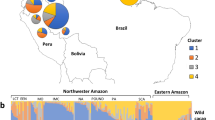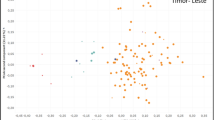Abstract
Phenotypic divergence among the 24 accessions belonging to a collection of six species of Capsicum from different geoclimatic regions available in field gene bank of CIMAP, Lucknow, India, was quantified by multivariate analysis for 12 quantitative and qualitative traits. Based on their values, all 24 accessions were grouped into six clusters such that the genetic stocks within cluster had smaller D 2 values among themselves than those belonging to different clusters. The accessions of Capsicum annuum were distributed in different clusters in morphotyping representing different species, suggesting that taxonomic characteristics are not always related to agronomic traits. No parallelism/association was found between geographical and phenotypic diversity. Accessions 15 and 23 (clusters V and VI, respectively) had distinct identity. The three characteristics that played the greatest role in differentiation were fruit diameter, number of fruits per plant, and leaf diameter, which can be utilized as conventional/morphological markers for the improvement of chilli yield and obtaining good segregants in chilli breeding programs.


Similar content being viewed by others
References
Choudhary BS, Samadia DK (2004) Variability and character association in chilli landraces and genotypes under arid environment. Indian J Hortic 61:132–136
Cochran HL (1940) Characters for the classification and identification of varieties of Capsicum. Bull Torrey Club 67:710–717. doi:10.2307/2481333
Keshavram N, Saini SS (1971) Compatibility studies in some Capsicum species. Himachal J Agric Res 1(1):34–39
Mahalanobis PC (1936) On the generalized distance in statistics. Proc Natl Acad Sci USA 2:49–55
Misra CH, Pandey N, Chaubey GS (2004) Genetic divergence in rain fed semi-deep water rice germplasm. Indian J Agric Res 38:273–277
Munshi AD, Behra TK, Singh G (2000) Correlation and path analysis in chilli. Indian J Hortic 57:157–159
Narayanankutty C, Sunanda CK, Jaikumaran U (2005) Genetic divergence in pole type vegetable cowpea. Indian J Hortic 62:354–357
Peter KV, Rai B (1976) Genetic divergence in tomato. Indian J Genet 36:376–383
Pickersgill B (1988) The genus Capsicum: a multidisciplinary approach to the taxonomy of of cultivated & wild plants. Biol Zent Bl 107:381–389
Prince JP, Lackney VK, Angeles C, Blauth JR, Kyle MM (1995) A survey of DNA polymorphism within the genus Capsicum and the fingerprinting of pepper. Genome 38:224–231. doi:10.1139/g95-027
Rao CR (1952) Advanced statistical methods in Biometrics Research. Wiley, New York, pp 1–120
Roy A, Sarma RN (1996) Multivariate analysis in chilli (Capsicum annuum L.). Ann Agric Res 17:130–132
Sarma RN, Roy A (1995) Variation and character association in chilli (Capsicum annuum L.). Ann Agric Res 16:179–183
Sreelathakumary I, Rajamony L (2004) Genetic divergence in chilli (Capsicum annuum L.). Indian J Hortic 61:137–139
Sunil KP, Rasheed A (1998) Cross compatibility in five species of Capsicum. J Spices Aromat Crop 7(1):35–38
Suzuki T (1984) Constituents of red pepper species: chemistry, biochemistry, pharmacology, and food science of the pungent principle of Capsicum species. The Alkaloids, vol XXIII. Academic, New York, p 237
Thul ST, Shasany AK, Darokar MP, Khanuja SPS (2006) AFLP analysis for genetic diversity in Capsicum annuum and related species. Nat Prod Comm 1(3):223–228
Weissenberg M, Schaeffler I, Menagem E, Barzilai M, Levy A (1997) Isocratic non-aqueous revesed-phase high-performance liquid chromatographic separation of capsanthin and capsorubin in red peppers (Capsicum annuum L.), paprika and oleoresin. J Chromatogr A 757:89–95. doi:10.1016/S0021-9673(96)00665-6
Acknowledgements
The authors express sincere thanks to Dr. Gerard Barendse, Nijmegen Botanical Garden, The Netherlands, D. Saikia for their kind help in germplasm collection, and Council of Scientific and Industrial Research (CSIR), India, for grants and fellowship.
Author information
Authors and Affiliations
Corresponding author
Rights and permissions
About this article
Cite this article
Thul, S.T., Lal, R.K., Shasany, A.K. et al. Estimation of phenotypic divergence in a collection of Capsicum species for yield-related traits. Euphytica 168, 189–196 (2009). https://doi.org/10.1007/s10681-009-9882-y
Received:
Accepted:
Published:
Issue Date:
DOI: https://doi.org/10.1007/s10681-009-9882-y




